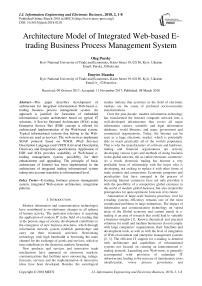Architecture model of integrated Web-based e-trading business process management system
Автор: Oleg Pursky, Dmytro Mazoha
Журнал: International Journal of Information Engineering and Electronic Business @ijieeb
Статья в выпуске: 2 vol.10, 2018 года.
Бесплатный доступ
This paper describes development of architecture for integrated informational Web-based e-trading business process management system. An approach is justified for formation of embedded informational system architecture based on typical IT solutions. A Service Oriented Architecture (SOA) using Enterprise Service Bus (ESB) concept is offered for architectural implementation of the Web-based system. Typical informational systems that belong to the Web-system are used as services. The web-services implement SOAP protocol based on WSDL (Web Services Description Language) and UDDI (Universal Description, Discovery and Integration) specifications. Application of ESB and SOA provides scalability of Web-based e-trading management system, possibility for their enhancement and upgrading. The principle of basic architecture of Internet has been implemented in the architecture of integrated trading informational system taking into account transition to informational level.
E-trading, business process management system, integrated Web-system architecture, integration patterns
Короткий адрес: https://sciup.org/15016122
IDR: 15016122 | DOI: 10.5815/ijieeb.2018.02.01
Текст научной статьи Architecture model of integrated Web-based e-trading business process management system
Published Online March 2018 in MECS
Modern information and communication technologies have contributed to revolutionary changes in all spheres of human activity. The particular relevance is acquiring the application of modern IT in the field of e-trading that at the present stage of society development contributes to the emergence of new business structures, which through information network system establish partnerships and carry out their economic activities. Networking technology with high bandwidth is becoming the main channel for the exchange of goods and services, which in turn contributes to the electronic markets formation.
New products and services and innovative trade mechanisms have appeared on electronic markets; communications that facilitate news outsourcing, ratings, forecasts, services and the implementation of innovative ideas have been developed. Besides, the sociological studies indicate that activities in the field of electronic markets are the cause of profound socio-economic transformations.
Automation of large-scale business processes vital for e-trading systems efficiency remains one of the most complicated problems in large enterprises. The impact of information and communication technology on varied areas of the Global economy and current trends in etrading is an area of research that could lead to valuable e-business insights [1]. Known theoretical and practical solutions for small and medium businesses do not comply with large companies’ requirements, their functions and development tools, as well as with the level of integration of Web-environment and enterprise management systems [2, 3]. The efficient IT support for e-trading is deterred with architecture and capabilities of informational systems not focused on creating an interconnected etrading network. Launching new Web-stores is generally accompanied with provision of redundant IT infrastructure leading to the increase of maintenance costs, misallocation, worse process governance and considerable losses. Insufficient use of capabilities takes place in e-purchasing, as well as in optimization and systematization of logical processes for automated development of trade list and product distribution patterns performed by integrating informational systems of companies and wholesale online markets. The lack of current e-commerce architectures to support pluggable services is a potential obstacle for more flexible and scalable collaboration in e-commerce [4]. This problem becomes more challenging in respect of commodity flow management in a Web-store network with a trade list comprising hundreds of thousands of items. Many companies tend to reduce their inventories and costs by adopting customized trading methods that allow them to considerably reduce their current assets and operational costs, as well as to considerably improve their range and turnover. However, experience has proven that achievement of such results is too difficult for companies with large turnover due to lack of informational process management methods that provide support of new business models for interaction of e-trading businesses with suppliers [5].
Businesses that run many Web-stores face sensitive issues: - how to sell different products on different landing pages with different trading policies by use of a single informational system; - how to manage multiple Web-stores using single informational system’s capabilities; - how to build architecture of such system and how to successfully re-engineer business processes during transferring to a new e-trading level; - how to generate a greater number of Web-stores without boosting their linear infrastructure, saving money on Web-stores development; - how to manage huge orders and product flows without storing large amounts of products.
Many large companies that have powerful resources and capabilities are unable to respond those modern challenges. Some of them face negative consequences of lacking system approach to IT project development and introduction; so, redundancy of informational systems leads to uncontrolled and inefficient decisions and direct losses of companies.
-
II. Basic Prerequisites for Model Design
Analysis of e-trading (ET) functional model and diagram of association between business blocks and ET organizational components and functional modules [7] shows that every functional module can be associated with a typical informational systems (IS) (these types are listed and described in Table 1). Applying typical IS as components of integrated trading informational system (TIS) allow us to provide its determined structure, localize and classify business processes, improve TIS and business processes management efficiency, and significantly improve TIS operation quality. Use of typical ERP-class IS and unified solution by means of applying general rules and requirements to all typical IS allows to provide necessary technical level, quality and efficiency of IS operation, IS development and maintenance costs reduction, IS development timeframe reduction.
Table 1. Making up main IS of integrated TIS
|
IS 1 |
Purpose |
|
Landing Web-pages management unit (LPMU) |
|
|
Management of online storefronts |
Managing of design and appearance of online storefronts |
|
Products and services information management |
Products data analytics, forming a unique offer catalogue, standardization and unification |
|
Customer management |
Addressable personalized customer interaction. Buyers’ opinion monitoring, distributing information, account and personal statistics management, partner interaction, data exchange |
|
Advertising management of Products and services |
Allocation and display of advertisement, efficiency monitoring, interaction with advertising spaces |
|
Website management |
allocation and display of information on related products |
|
Web-enterprise management unit (WEMU) |
|
|
Range and services management |
Developing trading list and its renewal |
|
Web-store management |
Development and maintenance of main Web-store features |
|
Financial management |
Monitoring and development of financial flows, financial support, interaction with banks |
|
Orders and services handling management |
Receiving, confirming and documenting orders, monitoring orders and their fulfilment, event handling, interaction with all TIS main services |
|
Supply management |
Handling product supply, interaction with suppliers, trading list control |
|
Resource management |
Available resource management, storage house maintenance |
|
Order batching management |
Client-specific order batching |
|
Order delivery management |
Monitoring and management of product delivery with different delivery channels (dispatches, delivery services, mail) |
Additionally, implementation of an integrated TIS based on typical IS will allow to consider existing development methods as a basis for typical solution employed for large ET businesses represented with Webstore (WS) networks. Applying typical solutions and their unification level provides improvement of informational interaction within integrated TIS, as well as architectural adaptivity of the system required for stable operation under significant volatility of scope of business processes, departments, functionalities, reference documentation and processed data structure.
-
III. Justification of Possible Integration of Different Types Information Systems
Analysis of the research subject field, ET functional model [7] and business requirements allows to build a graph G = ( B,V ) of informational dependency of IS set included in integrated TIS (fig. 1), where В = { b i } is a set of IS making up an integrated TIS, V = { vi j } is a set of edges, provided that vi j edge displays relation of informational coordination of IS b i and b j during business functions implementation. G graph is finite, non-oriented, it contains m + n +3 vertices, where m is number of online storefronts, n is number of IS comprising integrated TIS. Graph vertices are designated as follows, b 1 – managing IS; b 2 – online storefronts network management IS; b 3 , ..., b2+m – individual Web stores’ IS; b3+m , ... , b2+m+т – IS included in enterprise management СIS (corporate information system) and auxiliary IS, while b 2+m+т corresponds to supply management IS; b 3+m+т – B2B class TIS. Graph edges (fig. 1) are considered equivalent, subject to Internet and Intranet technologies application.
Existence of central managing IS is one of the main business requirements during TIS development.
Clause 1 . Vertice b1 is the centre of G graph.
Proof . According to definition [8], graph centre is any vertex where the greatest distance to other vertices is minimal:
MBB ( b )= min { MBB ( b i )}, (1)
where МВВ ( b і ) is maximal distance between vertices:
MBB ( b i )= max { d ( b i ,b j )}, (2)
where d ( b і b j ) is distance between vertices b і and b j .
Graph centre is found with matrix D distances between vertices (table 2), which elements define the shortest distance between vertices. Construct a matrix D for G graph. Square matrix D has dimension of ( m + n + 3 )×( m + n + 3 ). According to G graph, it is given by following.
Table 2. D matrix and maximum distance МВВ ( b і )
|
мвв b ) |
2 |
3 |
4 |
… |
4 |
3 |
… |
3 |
4 |
|
b 3+m+n |
2 |
3 |
4 |
4 |
3 |
1 |
0 |
||
|
b 2+m+n |
1 |
2 |
3 |
3 |
1 |
0 |
|||
|
… |
1 |
2 |
3 |
… |
3 |
1&2 |
… |
1&2 |
2&3 |
|
b 3+m |
1 |
2 |
3 |
3 |
0 |
1 |
|||
|
b 2+m |
2 |
1 |
0 |
0 |
3 |
3 |
4 |
||
|
… |
… |
… |
|||||||
|
b3 |
2 |
1 |
0 |
0 |
3 |
3 |
4 |
||
|
b2 |
1 |
0 |
1 |
1 |
2 |
2 |
3 |
||
|
b1 |
0 |
1 |
2 |
… |
2 |
1 |
… |
1 |
2 |
|
b1 |
b2 |
b3 |
… |
b 2+m |
b 3+m |
… |
b 2 +m+n |
b 3+m+n |
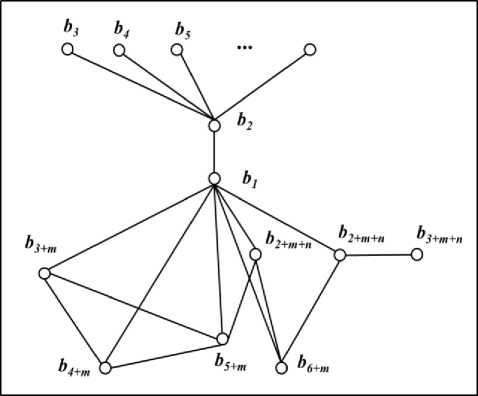
Fig.1. G graph for informational coordination of IS within TIS
Graph centre corresponds to a row of matrix D that contains a cell with the least maximum among all matrix rows [8]. Table 2 on the right shows the column that holds maximum values of each matrix row. The minimum value in column МВВ ( bі ) is located in the first row of D matrix. Thus, b 1 is the centre of G graph, which was to be proved. From the perspective of constructing integrated TIS, this justifies choosing b 1 as the central managing IS.
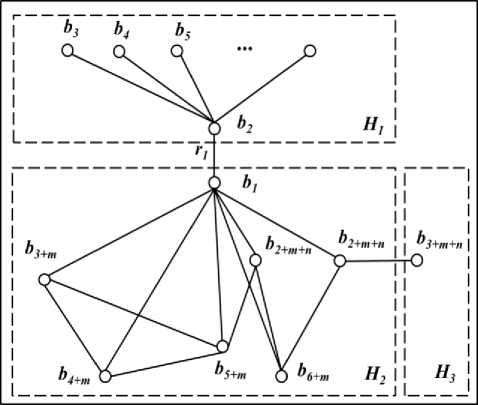
Fig.2. G 1 graph components
G is a connected graph, because any couple of its vertices is connected [9]. Edges ( b 1 , b 2 ) and ( b 2+m+n , b3+m+n ) are separating edges (bridges) [8, 9] because in graph G1 (Fig. 2) obtained by means of removal of those edges, couples of vertices b 1 і b 2 and b 2+m+n , and b 3+m+n appear to be not connected. In this way, G 1 graph includes three components (Fig. 2):
G 1 = H 1 U H 2 U Н 3 , (3)
where H1 subgraph includes vertices b2 , ... , b2+m and corresponds to network of online storefronts, while local graph degree H2 in the vertex equal to IS number ρ ( b2 )= m ; subgraph Н 2 includes vertices b 1 , b 3+m , ... , b 2+m+n and corresponds to the level of CIS; subgraph Н 3 is reduced to vertex b 3+m+n , because edge ( b 2+m+n , b 3+m+n ) is finite [9]. Subgraph Н 3 corresponds to В2В class TIS. Connected graph H 1 is a star-type graph defined by vertex b 2 , because b 2 is incident to all its edges5.
Clause 2 . Full graph U2 built on vertices b1 , b3+m , ... , b2+m+n corresponds to all possible aggregates of relations of informational coordination of IS within CIS.
Proof . Actually, each current state of informational coordination of IS within CIS corresponds to graph H 2 , which is subgraph of a complete graph U 2 .
Clause 3 . Enhancing graph G with vertex type b 2 , ... , b 2+m that corresponds to new WS, or vertex type b 3+m , ... , b2+m+n that corresponds to new IS within CIS, does not change the graph centre that remains in vertex b1 .
Proof. Enhancing graph G with vertex type b2, ... , b2+m that corresponds to new WS leads to adding a new row and a new column to matrix D (Table 2) that are similar to rows and columns with numbers 3, ..., 2+m, and additional element equal to 4 appears in the column with maximal value МВВ(bі). By that, minimum value equal to 2 remains located in the 1st row, which corresponds to vertex b1. Enhancing graph G with vertex (vertices) type b3+m, ... , b2+m+n that correspond(s) to new IS within CIS in matrix D (Table 2) leads to adding a row and a column to matrix that are similar to rows and columns with numbers 3+m, ..., 2+m+n, and additional element equal to 3 appears in the column with maximal value МВВ(bі). At that, minimum value equal to 2 remains located in the 1st row, which corresponds to vertex b1, which was to be proved. This property of G graph illustrates possibility of construction and further development of an integrated TIS by introduction of new WS and new informational subsystems.
-
IV. Architecture Model
Model-oriented design method is generally used in development of complicated IS based on existing solutions. Difficulties of its application mainly consist in extensive technical and labor costs for typical IS integration. This study is an approach used for solving the integration problem arising during construction of integrated TIS architecture, and this approach based upon use of integration patterns representing upper level of classification of design patterns [10].
Integrated system stability is improved with reduction in connections between separate IS that belong to enterprise’s informational structure. Although, lack of functional and informational connections between various typical IS can lead to limiting functionality of the TIS being created. In functional ET model [7], there are two loops selected (see Table 1), and repeated informational and functional interaction of different IS takes place in these loops. Meanwhile, there is a weak informational connection between IS of different loops. Thus, a method is required to provide a high level of informational and functional interaction inside these loops, while maintaining weak informational and functional interaction between those loops. To implement this method during the integrated TIS architecture design, strongly-connected IS should be concentrated into informational environments featuring weak mutual connection. Presence of separation edges in the graph model (Fig. 2) demonstrates that “vertex to vertex” architectural pattern should be applied for connection between informational environments.
WEMU loop construction (see Table 1) requires implementation of connection between separate IS inside the loop using “many to many” approach. As it was mentioned above, connections between IS within this loop should be weak and limited in number, otherwise risk of entropy growth will arise. Although, data volume and changing speed within WEMU loop are so high that applying weak connection approach can significantly reduce functionality of integrated TIS. Solving this problem requires architectural implementation that provides, on the one side, “many to many” connection, and on the other side, low functional connection and high informational integration level. “Bus” pattern provides this type of architectural implementation [11]. Applying this architectural pattern allows to eliminate a set of ambiguous direct connections between inhomogeneous typical IS within WEMU loop and streamlining informational processes and flows between the systems.
Regular interchange level between independent IS is insufficient for implementation a network of online storefronts. WEMU loop (see Table 1) forms a separate informational environment in which different subsystems are connected via common functions and algorithms. In accordance with star graph H1 of graph model (see Fig. 2), WEMU loop should be designed using “star” pattern that best fits for developing connected deterministic solutions based on single logic and functionality.
In this way, a mixed pattern is constructed for TIS architecture integration by means of organizing interaction between informational environments using “vertex to vertex” pattern and using “bus” and “star” patterns in informational environments. The approach under consideration provides ordering of selected informational environments and TIS designed as a whole. Using these design patterns improves integrated TIS stability relative to changing requirements and simplifies possible further modifications.
A noteworthy detail is improvement of informational security due to loops separation and weak connection between them. Unauthorized impact on IS in one of the loops does not lead to negative consequences in other one. This aspect should be one of important moments at support in implementing TIS informational and network security policy.
It is feasible to apply SOA using ESB for architectural implementation of WEMU loop. SOA is the most efficient modern application of integration architecture [12]. SOA application by means of using ESB concept allows to implement “bus” integration pattern within WEMU loop. It means a high level of informational integration for ET informational and business processes. Application of SOA and ESB improves WEMU loop flexibility and decreases IS dependencies within loop structure, providing a high level of informational connection between IS inside the loop. WEMU loop architectural organization is based on SOA and ESB whose main participants are service suppliers and service register. Typical IS belonging to WEMU loop (Table 1) are used as typical IS. At that, each typical IS is simultaneously data supplier and data consumer. It is important that data are available for online operation.
Each IS handles its own data class, while being able to both transmit and receive, adjust and modify data according to operational information from other IS and transmit data according to respective procedures, verifying their actuality at each stage of integrated information exchange within main business process.
Fig. 3 displays integrated TIS architecture model developed. Data exchange between services (local IS) is held using corporate service bus according to the following scheme: A service supplier registers his services in a register, and a customer refers to the service register via enterprise service bus.
Agreement abidance is vital for using the service. Service access interface should not depend on software application platform. ESB and SOA application provides services scalability, possibility of their enhancement and modernizing. Service provider and customer are not connected with the cross-platform interaction means, they are fully independent IS.
Since interface, data exchange methods and message formats are platform-independent, a flexible and scalable informational environment is formed with a potential to handle events independently in real-time mode, within specific IS, without impact on functioning mechanisms in general and independent on operational conditions.
In this way, ET business process apparatus and its formal logic scope are held to independent abstracted level that significantly improves management staff capabilities in business process modification.
It is important to notice that web-based services should be developed and used to enhance ESB efficiency [14]. Such web-services will implement SOAP and use WSDL (Web Services Description Language), as well as UDDI specification [15] (Universal Description, Discovery and Integration). These means make it possible to modify IS list as necessary, without modifying each of the services. It allows also to flexibly vary typical IS set that belong to informational environment, which is important enough for ET enterprise development.
From the perspective of the architecture proposed, each package should be independent, which implies transferring its structure, populating this structure with data and their transformation rules. This will certainly add to the exchanged data volume but this will also provide an additional opportunity to make data control during transmission an additional benefit. If a transmitted package has been described as a structure populated with data and containing rules it undergoes routing based on its identity and route determination. A similar approach is used, e.g. for routing IP-packages.
|
WS 1 landing Webpage |
WS 2 landing Webpage |
2. Landing Web-pages network |
WS n landing Webpage |
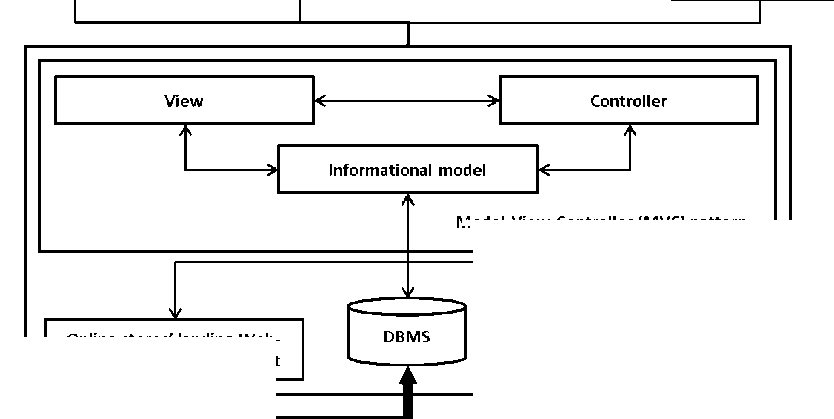
Model-View-Controller (MVC) pattern
Online stores landing Webpages content management
Online stores'landing Webpages management

3.TIS (B2B)
Supply plan shaping
Resource distribution
Suppliers selection
Orders placement
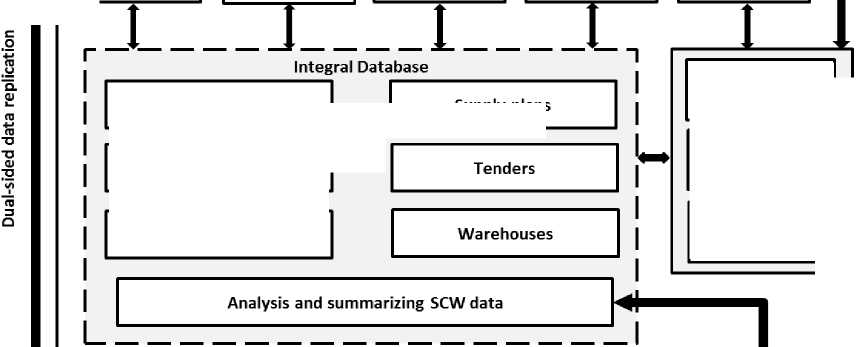
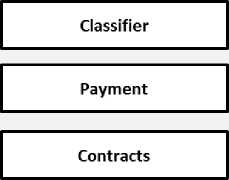
Supply plans
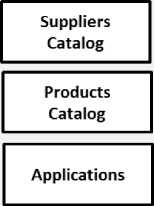

1. Enterprise management system
Delivery managemt IS
Supply managemt IS

Marketing managemt IS
Financial managemt IS
Fig.3. Model of architecture for integrated Web-based e-trading business process management system
A need of decision making at service or user level is complemented with pre-processing, thus acquiring a new capability of logic handling at an integrated system level. In this way, all management logic is brought at a higher level, thus giving full freedom in organization of communications between IS. Meanwhile, IS formal logic remains a part of IS themselves.
-
V. Results
Based on the analysis of functional [7] and graph model a method for creating architecture of an integrated TIS was developed. For creating this architecture design patterns were applied, independent information circuits, the central management system, junction points of circuits and interaction with B2B TIS were detailed. An architecture of implementation of SOA and ESB for enterprise control loop as well as MVC concept for control loop of a network of online storefronts were proposed. On the architectural level a basis for integration of technologically inhomogeneous complex information systems was laid. Necessary conditions for safe course of evolutionary cycles (in circuits themselves as well as directly inside the IS) were created in a way that with the course of time deformation of business processes would cause minimal influence on the basic structure of TIS architecture. A method of providing a high level of system controllability and integrity in conditions of its being distributed and in conditions of a high level of independence of separate nodes was developed based on allocation of the control system in form of the central IS with functions of data collecting and implementation of the controlling circuit on the basis of integrating circuit. Fulfillments of applied functionality criterion as well as fulfillment of requirements concerning electronic trading system flexibility adaptability, scalability and development were ensured.
-
VI. Conclusions
The principle of basic architecture of Internet is applied in an integrated TIS’ architecture developed while taking in account transfer to the informational level. Worldwide Web architecture that comprises a range of independent nodes has proved its stability and each node’s ability to evolve without corrupting whole network integrity, logic and connections degree. The connections degree is changing itself at the level of management logics that remains at a level abstracted from the nodes. Identical structure is inherited by local area nets that comprise global Internet and are similar to informational environments. Applying modern international experience of global IS structure to integrated TIS architecture design in large ET businesses makes it possible to provide proper conditions for meeting all major requirements of modern E-business to TIS. Architecture developed for integrated Web-based etrading business process management system provides dependability, governance, scalability, and intense ET systems development under fast evolving of business processes. Productivity, reliability and efficiency improvement for each of the logical units such as typical IS makes it possible to implement synergistic effect that could not be achieved by each separate IS. In its turn, it provides an opportunity to meet main conceptual, qualitative and quantitative requirements to an integrated web-system and creates conditions for maximal automation of ET business processes and corporate costs reduction under continuously changing external conditions.
Acknowledgment
This study was supported by the Ukrainian Ministry of Education and Science, Project No. 0117U000507, “Modeling the mechanisms of international e-commerce operation”.
Список литературы Architecture model of integrated Web-based e-trading business process management system
- Premkumar Balaraman, Kalpana Kosalram, “E-commerce evaluation and e business trends”, International Journal of Information Engineering and Electronic Business (IJIEEB), No 5, pp. 9-16, 2012.
- M.J. Shaw, “E-business management: integration of web technologies with business models”, Boston: Kluwer Academic, 2003.
- R. Sperka, K. Slaninova, “The usability of agent-based simulation in decision support system of e-commerce architecture”, International Journal of Information Engineering and Electronic Business (IJIEEB), No 1, pp. 10-12, 2012.
- F. Aulkemeier, M.A. Paramartha, M.-E. Iacob and J. van Hillegersberg, “A pluggable service platform architecture for e-commerce”, Information Systems and e-Business Management, Vol. 14, No 3, pp. 469-489, 2016.
- D. Chaffey, “E-business and e-commerce management”, Prentice Hall, Financial Times, 2011.
- Maciej Lasota, Stanisław Deniziak, Arkadiusz Chrobot, “An SDDS-based architecture for a real-time data store”, International Journal of Information Engineering and Electronic Business (IJIEEB), Vol. 8, No. 1, pp. 21-28, 2016.
- O.I. Pursky, D.P. Mazoha and I.O. Zhariy, “The functional model of a web-enterprise with internet shopping network”, Problems of Economy, No 2, pp. 166-171, 2015.
- J. Evans, “Optimization algorithms for networks and graphs”, CRC Press, 1992.
- Narsingh Deo, “Graph theory with applications to engineering and computer science”, Dover Publications, 2017.
- M. Fowler, “Patterns of enterprise application architecture”, Goels Computer Hut, Pearson. 2012.
- G. Hohpe, “Enterprise integration patterns: designing, building, and deploying messaging solutions”, Professional, Addison-Wesley. 2004.
- F. Aulkemeier, M. Schramm, M.-E. Iacob, and J. van Hillegersberg, “A service-oriented e-commerce reference architecture”, Journal of Theoretical and Applied Electronic Commerce Research, Vol. 11, No 1, pp. 24-45, 2016.
- E. Newcomer, “Understanding web services: XML, WSDL, SOAP, and UDDI”, Professional, Addison-Wesley, 2002.
- R. Sen, H. Chinoy and T. Hull, “XML for EDI making e-commerce a reality”, 1st ed. Academic Press, 2010.
- T. Erl “Service-oriented architecture: analysis and design for services and microservices”, 2nd ed. Prentice Hall, 2016.

